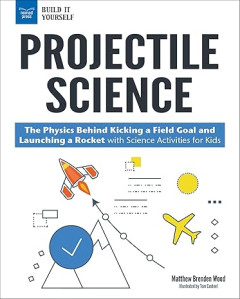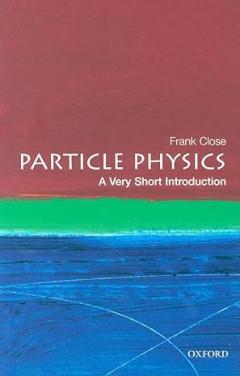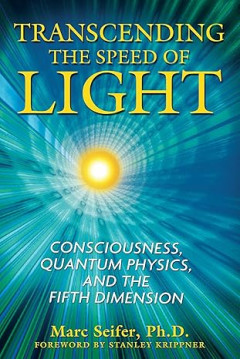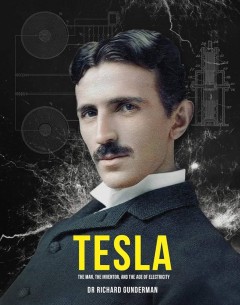Ditapis dengan

E-book Projectile Science: The Physics Behind Kicking a Field Goal and Launch…
What are the forces behind ballistics? Why do rocks and rockets soar through the air in an arch? The game is on the line. Suddenly, you hear the crack of a bat and the roar of crowd. Where will the ball land? How far will it travel? Is it a home run? You might think that hitting a home run or nailing a three-pointer is just luck, but there are many forces at work that determine if you’v…
- Edisi
- -
- ISBN/ISSN
- 9781619306783
- Deskripsi Fisik
- 198 halaman, ilus.
- Judul Seri
- -
- No. Panggil
- 530 WOO p

E-book Solved Problems in Classical Electromagnetism: Analytical and Numerica…
Classical electromagnetism - one of the fundamental pillars of physics - is an important topic for all types of physicists from the theoretical to the applied. The subject is widely recognized to be one of the most challenging areas of the physics curriculum, both for students to learn and for lecturers to teach. Although textbooks on electromagnetism are plentiful, hardly any are written in th…
- Edisi
- -
- ISBN/ISSN
- 9780198821922
- Deskripsi Fisik
- 656 halaman, ilus.
- Judul Seri
- -
- No. Panggil
- 530 PIE s

E-book Discovery in Physics
Volume 2 covers knowledge discovery in particle and astroparticle physics. Instruments gather petabytes of data and machine learning is used to process the vast amounts of data and to detect relevant examples efficiently. The physical knowledge is encoded in simulations used to train the machine learning models. The interpretation of the learned models serves to expand the physical knowledge re…
- Edisi
- -
- ISBN/ISSN
- 9783110785968
- Deskripsi Fisik
- 365 halaman, ilus.
- Judul Seri
- -
- No. Panggil
- 530 MOR d

E-book Particle Physics: A Very Short Introduction
In Particle Physics: A Very Short Introduction, best-selling author Frank Close provides a compelling and lively introduction to the fundamental particles that make up the universe. The book begins with a guide to what matter is made up of and how it evolved, and goes on to describe the fascinating and cutting-edge techniques used to study it. The author discusses particles such as quarks, elec…
- Edisi
- -
- ISBN/ISSN
- 9780192804341
- Deskripsi Fisik
- 160 halaman
- Judul Seri
- -
- No. Panggil
- 539.72 CLO p
E-book Percolation Theory Using Python
n this chapter we motivate the study of disordered media through the example of a porous system. The basic terms in percolation theory are introduced, and you learn how to generate, visualize and measure on percolation systems in Python. We demonstrate how to find exact results for small systems in two dimensions by addressing all configuration…
- Edisi
- -
- ISBN/ISSN
- 9783031599002
- Deskripsi Fisik
- 221 hlm
- Judul Seri
- -
- No. Panggil
- 530.072 MAL p
E-book Atomic Physics for Everyone: An Introduction to Atomic Physics, Quantu…
This open access textbook introduces beginning undergraduate students and high school students to the world of quantum mechanics and atomic spectroscopy. Requiring no previous knowledge of physics and no math beyond basic algebra and sines and cosines, this book focuses on concepts to make the excitement of atomic physics more accessible for learners than ever before. It comes replete with lear…
- Edisi
- -
- ISBN/ISSN
- 9783031695070
- Deskripsi Fisik
- 261 halaman, ilus.
- Judul Seri
- -
- No. Panggil
- 530.12 RAV a

E-book Mechatronics: Principles, Technologies and Applications (Mechanical En…
Mastering the art of mechatronics' currently looks like one of the most attractive tasks of modern engineering technology and science. Many applications resort to the interdisciplinary approach of mechatronics to enhance the performance, quality and safety of either product or process. Some are very traditional (like hard disk drives, biomedical, automotive and aerospace systems) while others a…
- Edisi
- -
- ISBN/ISSN
- 9781634828017
- Deskripsi Fisik
- 258 halaman, ilus.
- Judul Seri
- -
- No. Panggil
- 621 BRU m

E-book The Physics Book: From the Big Bang to Quantum Resurrection, 250 Miles…
Following the hugely successful The Science Book and The Math Book comes a richly illustrated chronology of physics, containing 250 short, entertaining, and thought-provoking entries. In addition to exploring such engaging topics as dark energy, parallel universes, the Doppler effect, the God particle, and Maxwells demon, the books timeline extends back billions of years to the hypothetical Big…
- Edisi
- -
- ISBN/ISSN
- 9781402790997
- Deskripsi Fisik
- 606 halaman, ilus.
- Judul Seri
- -
- No. Panggil
- 530 PIC t

E-book Do Colors Exist?: And Other Profound Physics Questions
Why do polished stones look wet? How does the Twin Paradox work? What if Jupiter were a star? How can we be sure that pi never repeats? How does a quantum computer break encryption? Discover the answers to these, and other profound physics questions! This fascinating book presents a collection of articles based on conversations and correspondences between the author and complete strangers ab…
- Edisi
- -
- ISBN/ISSN
- 9783319643601
- Deskripsi Fisik
- 286 halaman
- Judul Seri
- -
- No. Panggil
- 530.1 COT d
E-book Quantifying Quality of Life : Incorporating Daily Life into Medicine
There are many ways to define health. Health is defined by the World Health Organization (WHO) as “a state of complete physical, mental and social well-being and not merely the absence of disease or infirmity.” [1, 2] This definition has recently been challenged by a team of international experts who suggested that health be defined as “the ability to adapt and …
- Edisi
- -
- ISBN/ISSN
- 9783030942120
- Deskripsi Fisik
- 595 hlm
- Judul Seri
- -
- No. Panggil
- 610.153 WUL q

E-book Transcending the Speed of Light: Consciousness, Quantum Physics, and t…
A study of the new scientific understanding of consciousness and the mind as a fifth dimension of reality • Introduces the existence of a fifth dimension--one of mind--an inner- or hyperspace where time is transcended • Shows how the barrier of the speed of light is actually a gateway demarking the fifth dimension Since the introduction of Descartes’ dualism in the seventeenth ce…
- Edisi
- -
- ISBN/ISSN
- -
- Deskripsi Fisik
- 350 halaman
- Judul Seri
- -
- No. Panggil
- 530.12 SEI t
E-book Genius: The Life and Science of Richard Feynman
From the author of the national best seller Chaos comes an outstanding biography of one of the most dazzling and flamboyant scientists of the 20th century that "not only paints a highly attractive portrait of Feynman but also . . . makes for a stimulating adventure in the annals of science." (The New York Times).
- Edisi
- -
- ISBN/ISSN
- -
- Deskripsi Fisik
- 564 halaman
- Judul Seri
- -
- No. Panggil
- 925.3 GLE g

E-book Enrico Fermi: The Obedient Genius
This biography explores the life and career of the Italian physicist Enrico Fermi, which is also the story of thirty years that transformed physics and forever changed our understanding of matter and the universe: nuclear physics and elementary particle physics were born, nuclear fission was discovered, the Manhattan Project was developed, the atomic bombs were dropped, and the era of “big sc…
- Edisi
- -
- ISBN/ISSN
- 9781493935314
- Deskripsi Fisik
- 355 halaman
- Judul Seri
- -
- No. Panggil
- 925.3 BRU e
E-book Six Easy Pieces: Essentials of Physics Explained by Its Most Brilliant…
It was Richard Feynman's outrageous and scintillating method of teaching that earned him legendary status among students and professors of physics. From 1961 to 1963, Feynman delivered a series of lectures at the California Institute of Technology that revolutionized the teaching of physics around the world. Six Easy Pieces, taken from these famous Lectures on Physics, represent the most access…
- Edisi
- -
- ISBN/ISSN
- 9780465025299
- Deskripsi Fisik
- 177 halaman
- Judul Seri
- -
- No. Panggil
- 530 FEY s
E-book How It Works: Book of Amazing Electricity
- Edisi
- -
- ISBN/ISSN
- -
- Deskripsi Fisik
- 29 halaman, ilus.
- Judul Seri
- -
- No. Panggil
- 537 FUT h
- Edisi
- -
- ISBN/ISSN
- -
- Deskripsi Fisik
- 29 halaman, ilus.
- Judul Seri
- -
- No. Panggil
- 537 FUT h
E-book How It Works: Book Of Amazing Physics
- Edisi
- -
- ISBN/ISSN
- -
- Deskripsi Fisik
- 40 halaman, ilus.
- Judul Seri
- -
- No. Panggil
- 530 FUT h
- Edisi
- -
- ISBN/ISSN
- -
- Deskripsi Fisik
- 40 halaman, ilus.
- Judul Seri
- -
- No. Panggil
- 530 FUT h
E-book Textile in Architecture
The driving force behind this work came from the absence of textile material in Finnish architecture. The goal of this thesis is to bring together the information on architecture and textile and put together a package of information to support the use of architextiles in architecture. The study concentrates on the matter on a general level. The information is meant to serve several fields of s…
- Edisi
- -
- ISBN/ISSN
- -
- Deskripsi Fisik
- 97 hlm
- Judul Seri
- -
- No. Panggil
- 746 KUU t
E-book Quantum Physics
In developing quantum mechanics of pointlike particles one is faced with a curious, almost paradoxical situation: One seeks a more general theory which takes proper account of Planck’s quantum of action h and which encompasses classical mechanics, in the limit h ? 0, but for which initially one has no more than the formal framework of canonical mechanics. This is to say, slightly exaggerating…
- Edisi
- -
- ISBN/ISSN
- 9783642345630
- Deskripsi Fisik
- 746 hlm
- Judul Seri
- -
- No. Panggil
- 539 SCH q
E-book Physics Unit 6 : Temperature, Heat, and Thermodynamics
This e-book contains slide which explain about temperature, heat, and thermodynamics.
- Edisi
- -
- ISBN/ISSN
- -
- Deskripsi Fisik
- 123 hlm
- Judul Seri
- -
- No. Panggil
- 530 WRI p

E-book Detectors in Particle Physics: A Modern Introduction
This textbook provides an accessible yet comprehensive introduction to detectors in particle physics. It emphasises the core physics principles, enabling a deeper understanding of the subject for further and more advanced studies. In addition to the discussion of the underlying detector physics, another aspiration of this book is to introduce the reader to practically important aspects of parti…
- Edisi
- -
- ISBN/ISSN
- 9781003861577
- Deskripsi Fisik
- 348 halaman
- Judul Seri
- -
- No. Panggil
- 530 VIE d

E-book Power of the Invisible: The Quantessence of Reality
Quantum Physics is the solid basis of most of our understanding of nature and has been the driver of many technological advances. The trilogy Power of the Invisible: The Quintessence of Reality gives a coherent account of this huge domain of knowledge, which is linked to some fifty Nobel prizes and is one of the greatest scientific achievements of the twentieth century. This quantum story follo…
- Edisi
- -
- ISBN/ISSN
- 9789048562879
- Deskripsi Fisik
- 697 halaman
- Judul Seri
- -
- No. Panggil
- 539 BAI p

E-book Particle Accelerator Physics
This book by Helmut Wiedemann is a well-established, classic text, providing an in-depth and comprehensive introduction to the field of high-energy particle acceleration and beam dynamics. The present 4th edition has been significantly revised, updated and expanded. The newly conceived Part I is an elementary introduction to the subject matter for undergraduate students. Part II gathers the bas…
- Edisi
- -
- ISBN/ISSN
- 9783319183176
- Deskripsi Fisik
- 1029 halaman, ilus.
- Judul Seri
- -
- No. Panggil
- 530 WIE p
Hawking : The Man, The Genius, and The Theory of Everything
The death of Stephen Hawking in March 2018 brought to a close one of the most remarkable and inspiring scientific life stories of all time. Probably the greatest English cosmologist since Newton and the most celebrated scientist of the modern era, his story transcends the academic sphere. Struck down in his youth with a terrible disease and given just a few years to live, Hawking defied medical…
- Edisi
- -
- ISBN/ISSN
- 9780233005706
- Deskripsi Fisik
- 19 x 24 cm; 160 hlm
- Judul Seri
- -
- No. Panggil
- 925.3 LEV h

Tesla: The Man, the Inventor and the Age of Electricity (Great Thinkers)
Known as the father of modern electricity, Nikola Tesla’s work transformed the world. Devoted to discovery, the scientist and engineer registered more than 700 patents in his lifetime, from X-ray to radar, to the Tesla Coil, radio, and remote control. This illustrated biography follows the development of Tesla’s key theories and inventions, shining a light on an eccentric man who, ultimatel…
- Edisi
- -
- ISBN/ISSN
- 9780233005768
- Deskripsi Fisik
- 160 halaman, 24,5 cm X 19 cm, ilust
- Judul Seri
- -
- No. Panggil
- 920.71 GUN t

PHYSICS A LEVEL 1994-2004 FOR YEAR 1& 2: Actual Exam Papers, Worked Solutions…
- Edisi
- cet. 1
- ISBN/ISSN
- 9810033796
- Deskripsi Fisik
- ;19 x 26 cm
- Judul Seri
- -
- No. Panggil
- 530 TIM p
- Edisi
- cet. 1
- ISBN/ISSN
- 9810033796
- Deskripsi Fisik
- ;19 x 26 cm
- Judul Seri
- -
- No. Panggil
- 530 TIM p
 Karya Umum
Karya Umum  Filsafat
Filsafat  Agama
Agama  Ilmu-ilmu Sosial
Ilmu-ilmu Sosial  Bahasa
Bahasa  Ilmu-ilmu Murni
Ilmu-ilmu Murni  Ilmu-ilmu Terapan
Ilmu-ilmu Terapan  Kesenian, Hiburan, dan Olahraga
Kesenian, Hiburan, dan Olahraga  Kesusastraan
Kesusastraan  Geografi dan Sejarah
Geografi dan Sejarah